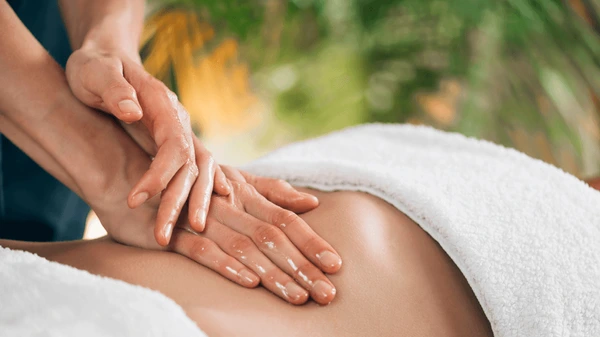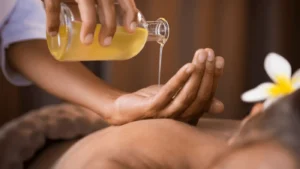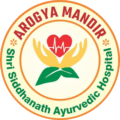Abhyanga - Ayurvedic Massage

Ayurveda has various holistic practices (therapies), and one of its key components is Abhyanga, the art of Ayurvedic massage therapy. In this article, we delve into the profound aspects of Abhyanga, exploring its history, benefits, techniques, and integration into modern lifestyles.
I. Introduction
Definition of Abhyanga
Abhyanga, derived from Sanskrit, translates to “oil massage.” It is a therapeutic and rejuvenating practice deeply rooted in Ayurvedic traditions. This form of massage involves the application of warm, medicated oils on the body, aiming to promote balance and vitality.
Brief History and Origin
Sushruta Acharya said that our body is made up of pure essence of oil. This is known as Sneh in Ayurveda. This is most important factor for proper functioning of our body. And to maintain it, our Ayurveda said to do oil massage. This massage is must needed therapy in Panchkarma as well.
II. Benefits of Abhyanga
Physical Benefits
The physical advantages of Abhyanga are extensive, ranging from improved circulation and flexibility to enhanced lymphatic drainage. The massage stimulates vital points in the body, promoting detoxification and boosting the immune system.
Mental and Emotional Benefits
Beyond the physical, Abhyanga extends its benefits to the realm of mental and emotional well-being. The calming effect of the massage helps alleviate stress, anxiety, and promotes mental clarity.
Improving Overall Well-being
The holistic nature of Abhyanga contributes to overall well-being by harmonizing the body and mind, fostering a sense of balance and rejuvenation.
Role of Abhyanga in Balancing Doshas
Central to Ayurveda is the concept of doshas, representing unique combinations of the five elements—earth, water, fire, air, and ether. Vata is made up of air and ether, Pitta is made up of fire element and Kapha is made up of earth and water element. This Dosha – Vata, Pitta, and Kapha doshas govern various physiological and psychological functions in the body.
Abhyanga plays a pivotal role in balancing these doshas, addressing imbalances that may lead to physical or mental discomfort. The choice of oils and massage techniques is tailored to an individual’s dosha constitution.
III. Ayurvedic Oils Used in Abhyanga
Overview of Commonly Used Oils
Ayurveda employs a variety of oils, each with specific properties catering to different dosha imbalances. Common choices include sesame, coconut, and almond oil, Kshirbala, Narayan, Murivenna, Kottamchukadi, Vishgarbha oil etc – each bringing unique therapeutic qualities. 
Choosing the Right Oil for Your Condition
Selecting the appropriate oil is crucial for an effective Abhyanga session. Specifying each condition and its appropriate oil here is not possible here. Here we are giving appropriate oil for most common issues in which massage is recommended.
- For Vata – Bala / Narayan / Sahacharadi Oil or Sesame oil
- For Pitta – Coconut oil, Chandanadi oil etc.
- For Kapha – Sahacharadi, Laxadi oil etc
- For Muscle relaxation – Kottam Chukkadi Oil
- For Rejuvenation – Murrivenna oil
- For Child and pregnant lady – Bala oil.
IV. The Abhyanga Technique
There are various types of Abhyanga – Ayurvedic Massage. Here are some of them which are commonly used in today’s era.
- Sanvahana – Very gentle massage
- Abhyanga – Medium pressure massage
- Mardan – Deep tissue massage.
- Marma Massage – energy restoring technique
- Shiro Abhyang – head massage
Step-by-step Guide to Performing Abhyanga
Executing Abhyanga involves a systematic approach, from warming the oil to applying it in rhythmic motions. A step-by-step guide ensures a fulfilling and relaxing experience, promoting optimal results.
- Select appropriate oil according to your prakruti and need.
- Warm the oil gently. Ask the person to lie in supine position.
- Pour 1 teaspoon of oil over umbilicus before starting the massage.
- Then start Abhyanga by massaging legs first. There are two opposite direction of massage. One is away from heart and other is towards the heart. It is necessary to consult ayurvedic physician first for determine which direction would be better.
- Speed and pressure are also important in massage. Slow, medium and fast massage with low, medium and high pressure is the key factor of authentic massage. This also depends on individual’s prakruti and need.
- Strokes – another important factor in massage is stroke. There are lots of stroke for each condition of person.
Tips for a Relaxing and Effective Massage
Calm and serene atmosphere with Aroma, using gentle strokes, and paying attention to specific body parts are essential tips for achieving the desired therapeutic effects of Abhyanga. Dim lighting, soothing music, and a comfortable environment enhance the overall experience.
V. Precautions and Contraindications
Instances When Abhyanga Is Not Recommended
While Abhyanga is generally safe, certain instances, such as during acute illness or pregnancy, may warrant caution. Understanding when to avoid the massage ensures the well-being of the individual. other conditions in which massage is prohibited are fever, acute headache and some skin disorders.
Precautions for Specific Health Conditions
Individuals with specific health conditions, such as skin disorders or allergies, should take additional precautions or consult a qualified Ayurvedic practitioner before engaging in Abhyanga.
VI. Integrating Abhyanga into Daily Routine
Discovering ways to seamlessly integrate Abhyanga into daily life enhances its accessibility and benefits. Simple adjustments to morning or evening routines can make this practice a consistent part of self-care. If a person don’t have much time for proper Abhyanga then he or she can apply oil over specific parts – which are area in front of ear, head and soles of leg. This short abhyanga also provide some kind of relaxation and rejuvenation
VII. Comparisons with Other Massage Therapies
Contrasting Abhyanga with Western Massage Techniques
While Western massage therapies focus on muscle manipulation, Abhyanga adopts a holistic approach, addressing the energy flow within the body. Understanding these differences allows individuals to choose a massage that aligns with their wellness goals.
Unique Aspects of Ayurvedic Massage
The uniqueness of Abhyanga lies in its emphasis on individual constitution, dosha balancing, and the spiritual connection between the practitioner and the recipient. These aspects distinguish it from conventional massage techniques.
VIII. Addressing Common Misconceptions
Debunking Myths About Abhyanga
- Myth – Ayurvedic Massage is very slow for providing deep relaxation.
- Fact – Ayurvedic Massage has numerous types in it. Depending upon person’s need we can provide deep tissue massage which is known as Mardan in Ayurveda.
- Myth – Massage without oil is better.
- Fact – Oil massage has lots of benefits like reducing dryness, increase skin tone and glow, improve inner functions, improve body energy etc. this benefits we don’t get in non-oiling massage.
- Myth – After ayurvedic massage, oil remains on skin for longer time and thus it damage daily cloths.
- Fact – After massage, we provide steam bath complimentary for maximum absorption of oil. Then Udvartan therapy removes extra oil from skin.
FAQs
Abhyanga is generally safe for most individuals, but certain health conditions may warrant caution. It’s advisable to consult with an Ayurvedic practitioner before starting.
The frequency of Abhyanga depends on your dosha and personal preferences. As a general guideline, 1-3 times a week is recommended.
While common oils include sesame, coconut, and almond, the best oil for you depends on your dosha. Consultation with an Ayurvedic expert can help determine the most suitable oil.
No, Abhyanga extends its benefits to mental and emotional well-being, promoting relaxation, reducing stress, and enhancing overall clarity of mind.
It’s advisable to avoid Abhyanga during the first trimester and seek guidance from a healthcare professional before proceeding during later stages of pregnancy
Uniqueness of our therapies
In Arogya Mandir – Shri Siddhanath Ayurvedic Hospital, Miraj, every patient is examined through ayurvedic perception deeply. By applying noninvasive Ayurvedic diagnostic tools like Ashtavidha Parikshan, Nadi Parikshan etc exact pathogenesis of disease is founded out and then therapies are advised according to condition of disease. Thus results come early.
Our therapies have following uniqueness.
- Silent, clean, therapy room with trained therapist and positive environment.
- Appropriate massage oil is selected according to Prakruti and disease condition of patient.
- Free Prakruti and Dhatu Sarata examination before starting of therapies.
- Authenticate procedure of each therapy.
- Appropriate use of herbal medicines and instruments during therapy.
- Special rooms with all facility for indoor patient.
Share this article for free.
Copyright message – This article is published on drchivateayurved.org by Dr. Prashant Chivate. This article is made for information about disease. Any other use of this article is strictly prohibited. All rights reserved
